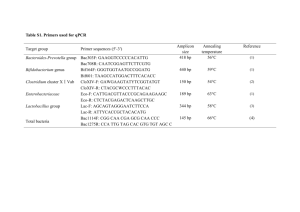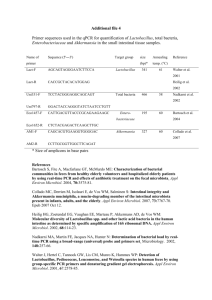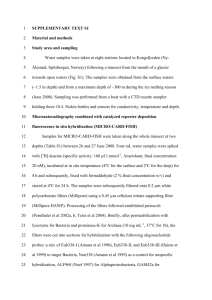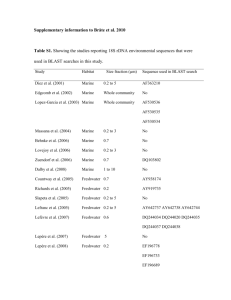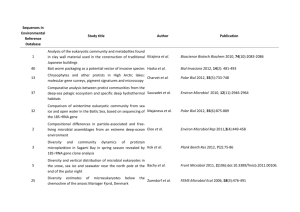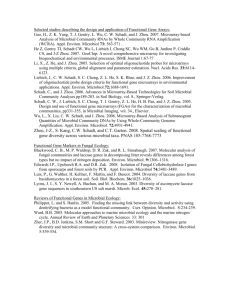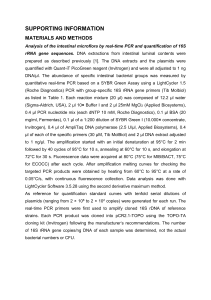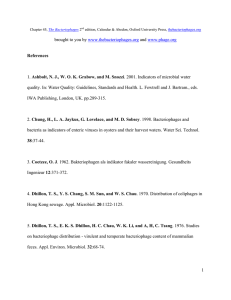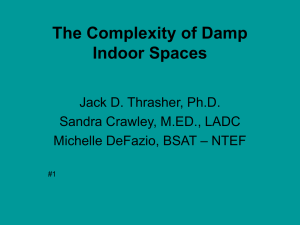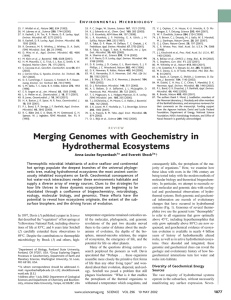emi412240-sup-0002-si
advertisement
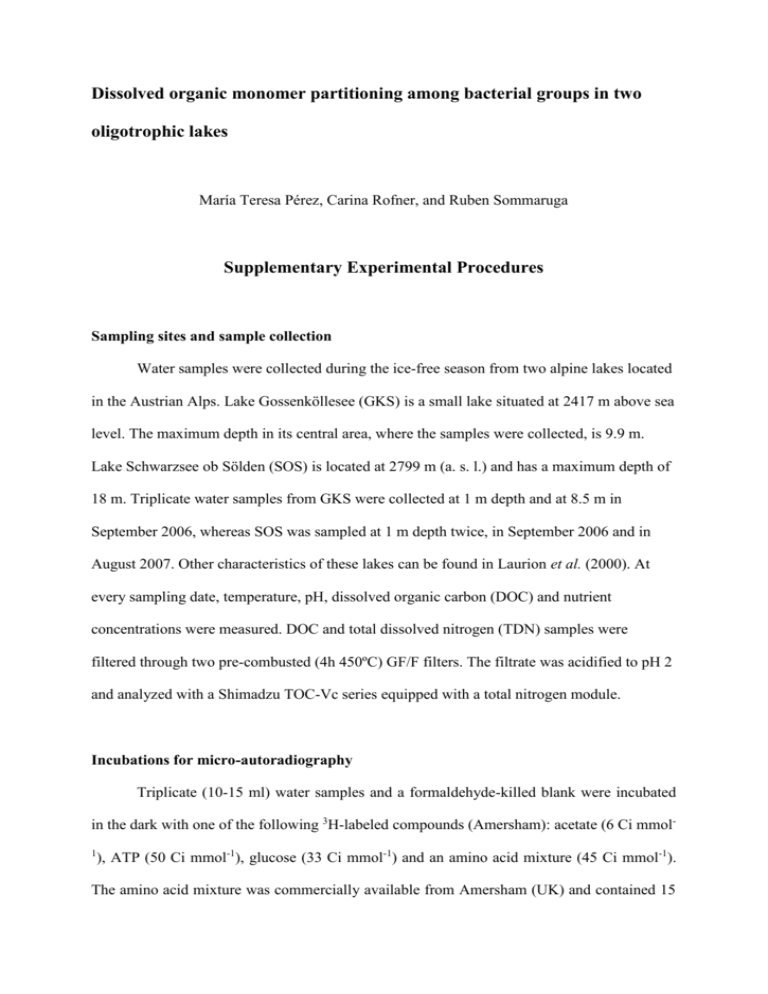
Dissolved organic monomer partitioning among bacterial groups in two oligotrophic lakes María Teresa Pérez, Carina Rofner, and Ruben Sommaruga Supplementary Experimental Procedures Sampling sites and sample collection Water samples were collected during the ice-free season from two alpine lakes located in the Austrian Alps. Lake Gossenköllesee (GKS) is a small lake situated at 2417 m above sea level. The maximum depth in its central area, where the samples were collected, is 9.9 m. Lake Schwarzsee ob Sölden (SOS) is located at 2799 m (a. s. l.) and has a maximum depth of 18 m. Triplicate water samples from GKS were collected at 1 m depth and at 8.5 m in September 2006, whereas SOS was sampled at 1 m depth twice, in September 2006 and in August 2007. Other characteristics of these lakes can be found in Laurion et al. (2000). At every sampling date, temperature, pH, dissolved organic carbon (DOC) and nutrient concentrations were measured. DOC and total dissolved nitrogen (TDN) samples were filtered through two pre-combusted (4h 450ºC) GF/F filters. The filtrate was acidified to pH 2 and analyzed with a Shimadzu TOC-Vc series equipped with a total nitrogen module. Incubations for micro-autoradiography Triplicate (10-15 ml) water samples and a formaldehyde-killed blank were incubated in the dark with one of the following 3H-labeled compounds (Amersham): acetate (6 Ci mmol1 ), ATP (50 Ci mmol-1), glucose (33 Ci mmol-1) and an amino acid mixture (45 Ci mmol-1). The amino acid mixture was commercially available from Amersham (UK) and contained 15 different amino acids. Among them five amino acids (leu, ile, ala, glu and ser) represented ca. 56% of the total mixture. The substrates were added at trace concentrations (1-2 nM) and incubated for 5 hours at in situ temperature. Incubations ended with the addition of formaldehyde (2% final concentration) to the samples. Samples were kept at 4 °C overnight and then filtered onto 0.22 µm white polycarbonate filters (Millipore GTTP), rinsed with 0.22 µm filtered Milli-Q water, air dried and then stored at -20°C until analysis. CARD-FISH and micro-autoradiography analysis CARD-FISH was done according to Pernthaler et al. (2002) using the permeabilization protocol of Sekar et al. (2003), modified for freshwater bacteria. We used the following horseradish peroxidase-labeled oligonucleotide probes : probe EUB I-III (Daims et al., 1999) targeting most Bacteria, BET42a (Manz et al., 1992) for Betaroteobacteria, R-BT065 (Šimek et al., 2001) for the R-BT subgroup of Betaproteobacteria, HCG69a (Roller et al., 1994) for Actinobacteria, AcI852 (Warnecke et al., 2005) for the AcI clade of Actinobacteria, and CF319a (Manz et al., 1996) detecting most of Cytophaga-Flavobacteria of Bacteroidetes. All hybridizations were run at 35°C overnight, followed by 30 min amplification. Following CARD-FISH procedure, cells were transferred to coverslips and subjected to microautoradiography (Cottrell and Kirchman, 2000). The optimum exposure time was assessed by monitoring the detection of positive cells for a given substrate until a maximum was reached. Slides were exposed for six (amino acid mixture), seven (ATP and glucose) or 10 days (acetate). After exposure, slides were developed according to the manufacturer instructions (Kodak) and mounted with an anti-fading solution (1x Citifluor, 2x Vectashield and 1x PBS) containing DAPI (final concentration 1 µg ml-1). Slides were stored frozen until the microscopy analysis. Cells were counted in at least 20 randomly selected microscopic fields. Routinely, at least 400 DAPI-stained cells were counted per sample or 1000 DAPI-stained cells, when the calculated relative abundance was < 1%. All in all ca. 300 individual preparations were analyzed this way. References Cottrell, M.T., and Kirchman, D. (2000) Natural assemblages of marine proteobacteria and members of the Cytophaga-Flavobacter cluster consuming low and high molecular weight dissolved organic matter. Appl Environ Microbiol 66: 1692-1697. Daims, H., Bruhl, R., Amann, R., Schleifer, K.H., and Wagner, M. (1999) The domainspecific probe EUB338 is insufficient for the detection of all Bacteria: development and evaluation of a more comprehensive probe set. Syst. Appl. Microbiol. 22: 434-444. Laurion, I., Ventura, M., Catalan, J., Psenner, R., and Sommaruga, R. (2000) Attenuation of ultraviolet radiation in mountain lakes: Factors controlling the among- and within-lake variability. Limnol Oceanogr 45: 1274-1288. Manz, W., Amann, R., Ludwig, W., Wagner, M., and Schleifer, K.H. (1992) Phylogenetic oligodeoxynucleotide probes for the major subclasses of Proteobacteria: problems and solutions. Syst Appl Microbiol 15: 593-600. Manz, W., Amann, R., Ludwig, W., Vancanneyt, M., and Schleifer, K.H. (1996) Application of a suite of 16S rRNA-specific oligonucleotide probes designed to investigate bacteria of the phylum Cytophaga-Flavobacter-Bacteroides in the natural environment. Microbiology 142: 1097-1106. Pernthaler, A., Pernthaler, J., and Amann, R. (2002) Fluorescence in situ hybridization and catalyzed reporter deposition for the identification of marine bacteria. Appl Environ Microbiol 68: 3094-3101. Roller, C., Wagner, M., Amann, R., Ludwig, W., and Schleifer, K.H. (1994) In situ probing of gram-positive bacteria with high DNA G+C content using 23S rRNA-targeted oligonucleotides. Microbiology 140: 2849-2858. Sekar, R., Pernthaler, A., Pernthaler, J., Warnecke, F., Posch, T., and Amann, R. (2003) An improved method for quantification of freshwater Actinobacteria by fluorescence in situ hybridization. Appl Environ Microbiol 69: 2928-2935. Šimek, K., Pernthaler, J., Weinbauer, M.G., Hornák, K., Dolan, J.R., Nedoma, J. et al. (2001) Changes in bacterial community composition and dynamics and viral mortality rates associated with enhanced flagellate grazing in a mesoeutrophic reservoir. Appl Environ Microbiol 67: 2723-2733. Warnecke, F., Sommaruga, R., Sekar, R., Hofer, J.S., and Pernthaler, J. (2005) Abundances, identity and growth state of Actinobacteria in mountain lakes of different UV transparency. Appl Environ Microbiol 71: 5551-5559.
